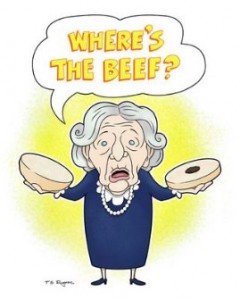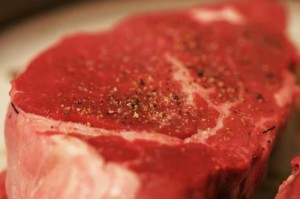By Jose Antonio PhD FISSN (www.theissn.org) – We all love protein. I tell my students to eat as much of it as they can. What’s the downside? Losing fat. Gaining muscle. Hardly a downside right? Now for a little lesson for all of you. Sarcopenia. You’ve probably heard the term somewhere. Scientists have defined sarcopenia is as an age-related decrease in muscle mass and performance. We know that short-term randomized controlled trials of muscle protein synthesis have demonstrated that whey protein increases synthesis more so than casein or soy isolates. Studies also suggest that essential amino acids stimulate muscle protein synthesis to a greater extent than nonessential amino acids.[1] So if you don’t want to be some Frail Freddy or Farrah, you better eat protein.
And as much as you might love whey protein, sometimes you just want to have a big fat juicy steak. So where’s the data on beef? It turns out there are some interesting bits of science on beef. For instance, scientists figured out the dose-response of muscle protein synthesis (MPS) with and without resistance exercise to graded doses of beef ingestion. Thirty-five middle-aged men (59 years) ingested 0 g, 57 g (2 oz; 12 g protein), 113 g (4 oz; 24 g protein), or 170 g (6 oz; 36 g protein) of (15% fat) ground beef. Subjects performed a bout of unilateral (i.e. only one side of  the body exercised) resistance exercise to allow measurement of the fed state and the fed plus resistance exercise state within each dose. MPS was increased with ingestion of 170 g of beef to a greater extent than all other doses at rest and after resistance exercise. That is equal to 36 grams of actual protein. Also, resistance exercise was strong in stimulating myofibrillar MPS, and acted additively with feeding.[2] So lift weights and eat some beef.
the body exercised) resistance exercise to allow measurement of the fed state and the fed plus resistance exercise state within each dose. MPS was increased with ingestion of 170 g of beef to a greater extent than all other doses at rest and after resistance exercise. That is equal to 36 grams of actual protein. Also, resistance exercise was strong in stimulating myofibrillar MPS, and acted additively with feeding.[2] So lift weights and eat some beef.
Another study examined the relationship of beef and protein intake to nutrition status, body composition, and other variables in older adults 60-88 years of age. Beef intake (g/d) was positively correlated to muscle mass measured by mid-arm muscle area. Also, protein intake was positively associated with nutrition status, calf circumference, and body mass index in older adults. Thus, consuming lean cuts of beef in moderation may be a healthy way in which older adults can increase protein intake, preserve muscle mass and improve nutritional status.[3]
What about a head to head comparison of chicken versus beef? Let’s face it. How many meals of white meat chicken breast and broccoli can you possibly eat? How about some beef? Scientists examined changes in body weight and lipid profiles in a 12-wk, randomized, controlled trial, in which overweight women followed a lower calorie diet with lean beef or chicken as the primary protein source, while participating in a fitness walking program. Sedentary non-smoking middle-aged females followed calculated-deficit diets (-500 kcal daily) and were randomly assigned to the beef-consumption or chicken-consumption dietary group, while following a fitness walking program. After 12 weeks, weight loss was similar between the  beef-consumption (5.6 kg) and the chicken-consumption (6.0 kg) groups. Both groups showed significant reductions in body fat percentage and total and low-density lipoprotein cholesterol, with no differences between groups. This studied indeed proves that weight loss and improved lipid profile can be accomplished through diet and exercise, whether the dietary protein source is lean beef or chicken.[4]
beef-consumption (5.6 kg) and the chicken-consumption (6.0 kg) groups. Both groups showed significant reductions in body fat percentage and total and low-density lipoprotein cholesterol, with no differences between groups. This studied indeed proves that weight loss and improved lipid profile can be accomplished through diet and exercise, whether the dietary protein source is lean beef or chicken.[4]
Top Sirloin Please!?
References
1. Beasley JM, Shikany JM, Thomson CA: The role of dietary protein intake in the prevention of sarcopenia of aging. Nutr Clin Pract 2013, 28:684-690.
2. Robinson MJ, Burd NA, Breen L, Rerecich T, Yang Y, Hector AJ, Baker SK, Phillips SM: Dose-dependent responses of myofibrillar protein synthesis with beef ingestion are enhanced with resistance exercise in middle-aged men. Appl Physiol Nutr Metab 2013, 38:120-125.
3. Asp ML, Richardson JR, Collene AL, Droll KR, Belury MA: Dietary protein and beef consumption predict for markers of muscle mass and nutrition status in older adults. J Nutr Health Aging 2012, 16:784-790.
4. Melanson K, Gootman J, Myrdal A, Kline G, Rippe JM: Weight loss and total lipid profile changes in overweight women consuming beef or chicken as the primary protein source. Nutrition 2003, 19:409-414.

